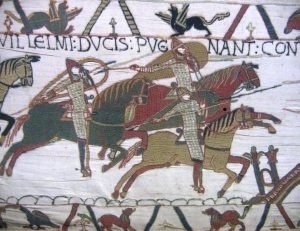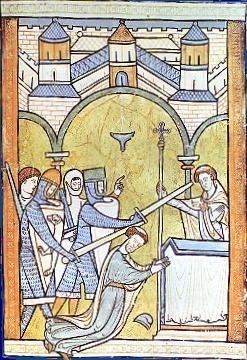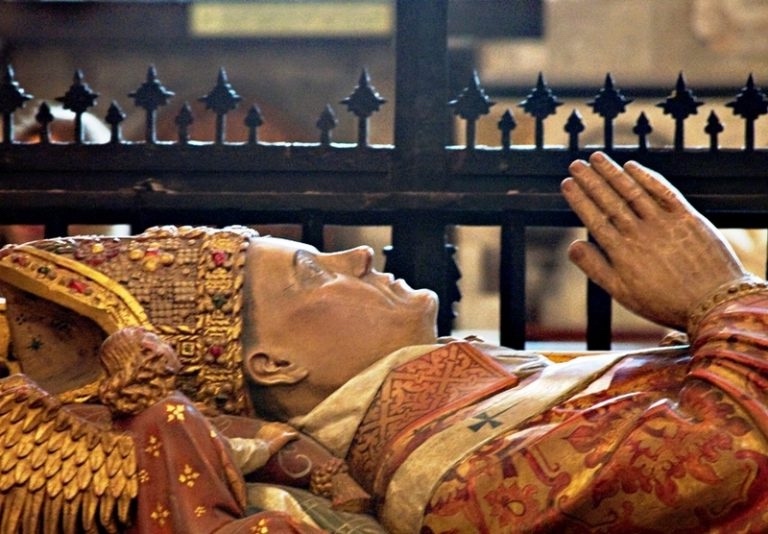
The Norman Conquest
Before the coming of St. Augustine in 597, the churches in Britain had little contact with Rome. The Church of England, in fact, was left largely undisturbed until the Norman Conquest in the year 1066. A that time, William, Duke of Normandy (William the Conqueror), had his banners blessed by the Pope before he invaded England and the assumption seems to have been that William would bring the English church further within the sphere of Roman influence. Even so, the new king went on to resist papal claims of world-wide jurisdiction. When Pope Gregory VII (1073-1085) demanded that King William pay homage to him as superior authority, he refused on the grounds that none of his predecessors had ever rendered homage to a pope, and that he himself had never promised to do so. In so doing, William set a precedent of independence that would expanded by later English kings.
The first Archbishop of Canterbury under Norman rule was a vigorous and dedicated administrator named Lanfranc. It was he who secured the right of primacy for Canterbury over York, and instituted the practice of summoning regular synods. His successor and former pupil, St. Anselm, was one of the greatest scholars of the High Middle Ages and is now regarded as one of the Doctors of the Western Church. He is generally thought of as the 「father of scholasticism」 and his ontological argument for the existence of God still exercises the minds of philosophers today. In the realm of theology, His Cur Deus Homo (Why The God-Man) is an outstanding treatise on the Incarnation and means of Atonement.
The coming of the Normans also saw a rise in monasticism. In addition to the long established Benedictines, new orders were being formed to resist the pull of worldliness, and to provide pastoral care for a growing population. The Cistercians and Carthusians adopted strict rules and withdrew to the borders of society, while the Augustinian Canons embraced the role of preachers and pastors, assisting the secular clergy in their ministrations to the people. All of these received patronage from the magnates and the crown, and as such, spread rapidly throughout the realm. In 1148 Gilbert of Sempringham gained papal approbation for a religious community of canons regular under his guidance, thus becoming the only Englishman to found a monastic order. The Gilbertines remained popular in England until the Dissolution of the Monasteries in some four hundred years later.
Conflict between Church and Crown One of the more tragic episodes in English Church history occurred in 1170, when Thomas á Becket, Archbishop of Canterbury, was murdered in his cathedral church by four knights of King Henry II. Though the king himself disclaimed any intention of causing the Archbishop’s death, he had in a fit of anger, denounced Becket and called him a traitor. His knights it seems, took his words more seriously than he meant, and took justice into their own hands. In response from growing pressure both at home and from abroad, the King did his best to make amends for the murder, submitting himself to a humiliating penance and allowing the cult of the newly canonized Becket to be established at Canterbury. A chapel at the east end of the Cathedral was made into a shrine, and for the next three centuries, it was the main focus of pilgrimage in the British Isles.

One of the sons of Henry II was John, generally considered to be one of the least effective English kings. When Hubert Walter, the Archbishop of Canterbury died in 1205, John became embroiled in a dispute with the cathedral chapter and the bishops of the southern province that would have disastrous consequences for his reign. Each party favored a different canditate as Walter’s successor, and when the Canterbury monks appealed to Innocent III to resolve the dispute, the Pope disavowed all three, and instead chose the learned Stephen Langton, whom he consecrated at Rome. Because the Pope’s actions violated the long established custom that the king have a voice in such matters, John prevented for several years Langton from returning to Canterbury.
As a result of these actions, Pope Innocent threatened to remove John from the throne, to release all his subjects from their allegiance, and to request that the King of France enforce his decree. John, who had no strong hold on the loyalty of his subjects, admitted defeat, gave up the struggle, and, by way of submission, placed his crown at the feet of the papal legate. In doing so he surrendered the kingdom to the Pope and received it back as a vassal of Rome.
However, this was not the end of the affair. At a meeting in St. Paul’s Cathedral Church in London, Archbishop Langton presented a charter of liberties which became known as the Magna Carta or the Great Charter. Thought it is often thought of as a political document, the first article included the statement: 「The Church of England shall be free, and have her rights intact, and liberties uninjured.」 On 15 June 1215, the barons assembled in a meadow called Runnymede, not far from the City of London, and there induced King John to sign the document. Pope Innocent, who recognized the attempt to limit his claims to authority, called the Great Charter a 「low, ill-favored, disgraceful compact,」 declared it null and void, and released all signatories from its provisions. Archbishop Langton, however, disregarded the Pope’s declarations and ordered English cathedral Churches to have public readings of the charter twice a year. Even though Langton’s appointment was a Roman one, it is clear that in leading the movement for Magna Carta and continuing to support its provisions in opposition to the decrees of Rome, he was acting not as a Roman bishop, but in the interest of the English Church.
Crisis and Recovery As the thirteenth century wore on, the English Church enjoyed a period of relative stability. The universites at Oxford and Cambridge became centers of learning, and produced two of the greatest minds of the era–John Duns Scotus and William of Ockham. Scotus was a in important figure in the scholastic tradition, formulating an argument for the existence of God based on causality, and defending the doctrine of the Immaculate Conception. Ockham is generally thought of as the father of nominalism, a philosophy that argued against the existence of universals outside the human mind. He is perhaps better known for the concept of 「Ockham’s razor;」 that is, the simplest explanation for a phenomenon is usually the best. Ockham died in 1347, just prior to what is arguably the most devastating event in the history of Europe–the onset of the Black Death.
Striking Sicily in 1347, it spread rapidly across Europe, killing an estimated 50% of the population before its abatement in the early 1350s. In England entire villages were wiped out. Victims of rank included Edward III’s daughter, Princess Joan, and Thomas Bradwardine, a renowned scholar and Archbishop of Canterbury. After the plague subsided there was a great deal of social and economic upheval, and the church was no exception. High rates of mortality among the clergy, who appear to have been diligent about their duties despite the risk of infection, led to many parishes being neglected or poorly supplied. A general crisis in confidence occurred, which was not helped by the Great Western Schism (1378-1417), a division within the Church which saw as many as three different claimants to the papal throne. Leading churchmen of the era saw a need for reform, though they had differing opinions on how it should be carried out.

In England an Oxford don named John Wyclif turned his formidable intellect against the institutions of the Church, claiming its structure and hierarchy were part of the problem. In addition to attacking the religious orders, he advocated for the disendowment of the Church and the assumption of royal control. This attack on the established order, combined with his unorthodox teachings on transubstantiation and predestination, brought him into conflict with the ecclesiastical authorities, in particular William Courtenay, Archbishop of Canterbury. After a church council found certain of his teachings heretical, he was confined to his living at Lutterworth, where he wrote pamphlets against his enemies until his death in 1384. While Wyclif himself may have been radical in his approach, his ideas inspired many in the subsequent generation to a more moderate reform. After the death of Archbishop Thomas Arundel the canon lawyer and 「new man,」 Henry Chichele was elevated to the See of Canterbury. Assisted by a bench of bishops that included former Wycliffite, Philip Repingdon, Chichele curbed abuses, improved the standard of clergy education, and emphasized pastoral care. It is likely that the reforms carried out under his long episcopate (1414-1443) preserved the English Church and spared it from the violent upheval that accompanied the Reformation on the Continent.
In the latter half of the fifteenth century England was not without its problems, though, as rival claimants fought for the throne in what are now known as the Wars of Roses. These came to an end in 1485 when Henry Tudor defeated Richard III at the Battle of Bosworth Field. His accession to the throne brought a measure of stability to the realm, but contained the seeds of dissent. When Henry’s eldest son, Arthur, who was betrothed to the daughter of the King of Aragon, suddenly died in 1502, his younger brother, Henry, Duke of York became heir to the throne. To save the alliance that he had negotiated, the king offered Prince Henry in Arthur’s stead. Thus the marriage of Henry VIII to Catherine of Aragon was arranged, an event which would have significant implications for the English Church in the years ahead.